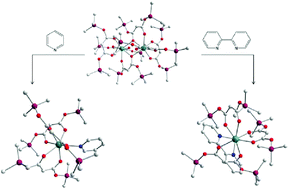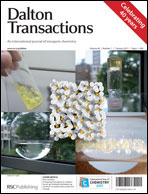A series of malonate complexes of dysprosium were synthesized as potential metalorganic precursors for Dy containing oxide thin films using chemical vapor deposition (CVD) related techniques. The steric bulkiness of the dialkylmalonato ligand employed was systematically varied and its influence on the resulting structural and physico–chemical properties that is relevant for MOCVD was studied. Single crystal X-ray diffraction analysis revealed that the five homoleptic tris-malonato Dy complexes (1–5) are dimers with distorted square-face bicapped trigonal-prismatic geometry and a coordination number of eight. In an attempt to decrease the nuclearity and increase the solubility of the complexes in various solvents, the focus was to react these dimeric complexes with Lewis bases such as 2,2′-biypridyl and pyridine (6–9). This resulted in monomeric tris-malonatomono Lewis base adduct complexes with improved thermal properties. Finally considering the ease of synthesis, the monomeric nature and promising thermal characteristics, the silymalonate adduct complex [Dy(dsml)3bipy] (8) was selected as single source precursor for growing DySixOy thin films by liquid injection metalorganic chemical vapor deposition (LI-MOCVD) process. The as-deposited films were analyzed for their morphology and composition by scanning electron microscopy (SEM), energy dispersive X-ray (EDX) analysis, Rutherford backscattering (RBS) analysis and X-ray photoelectron spectroscopy.

You have access to this article
 Please wait while we load your content...
Something went wrong. Try again?
Please wait while we load your content...
Something went wrong. Try again?


 Please wait while we load your content...
Please wait while we load your content...